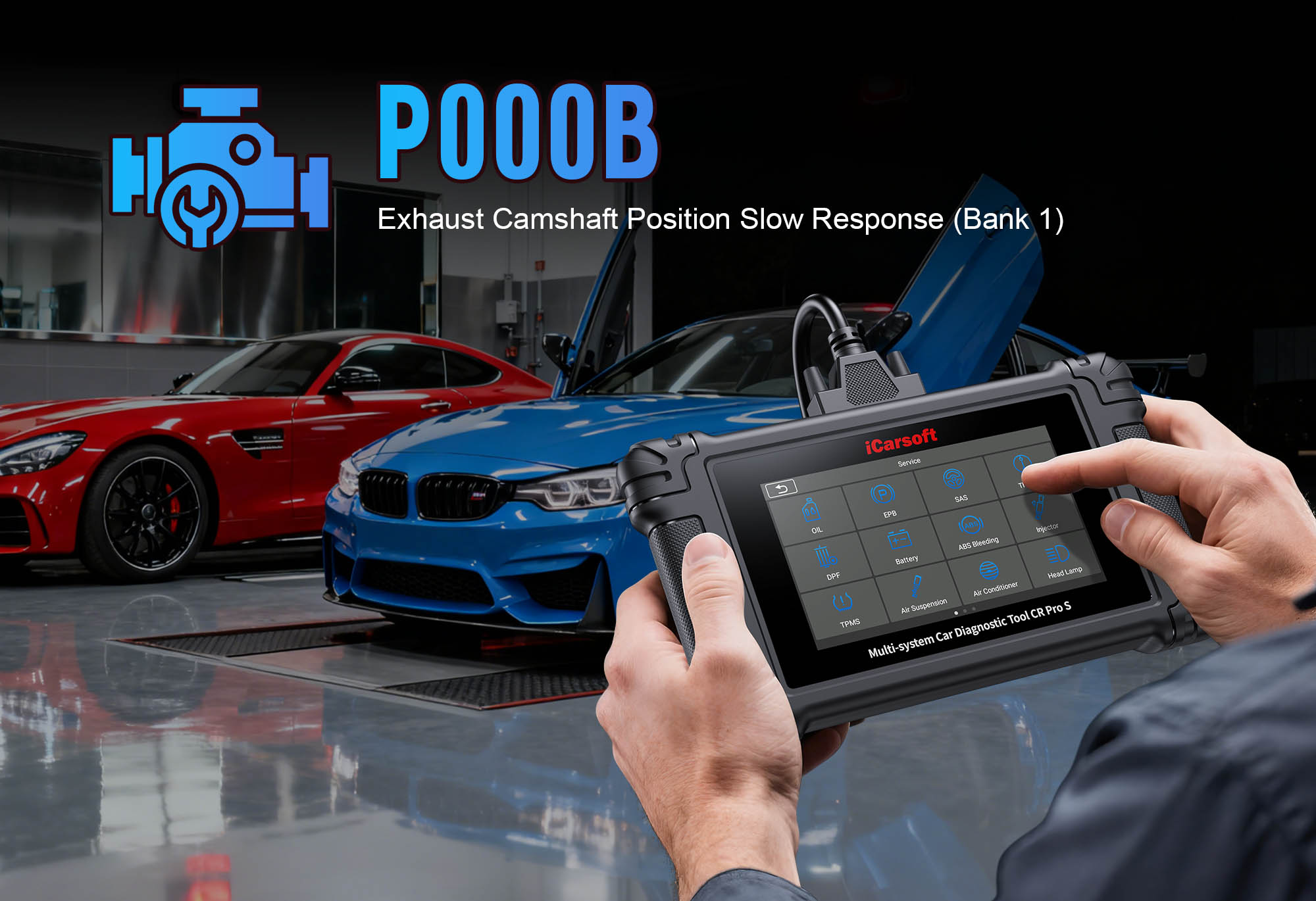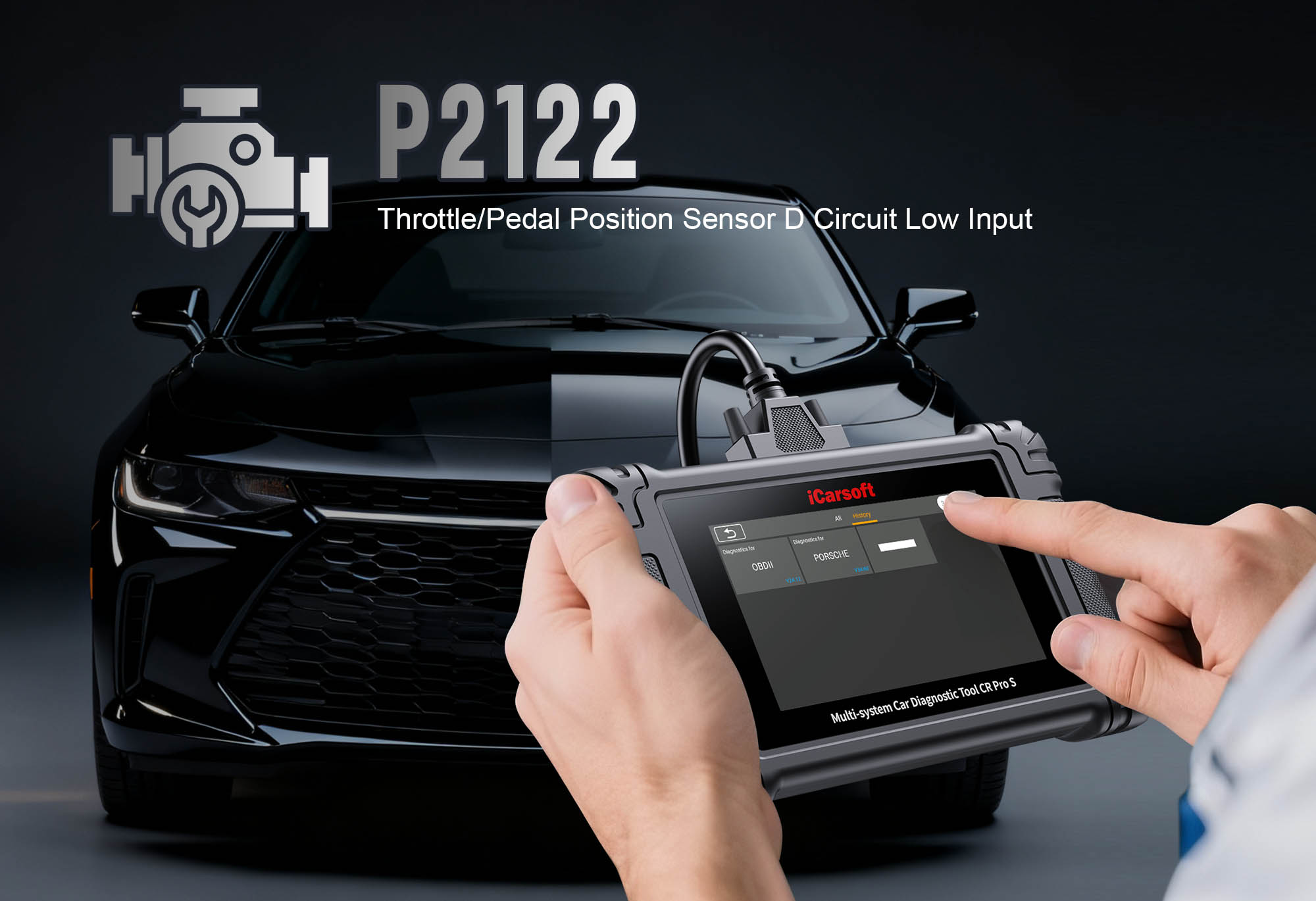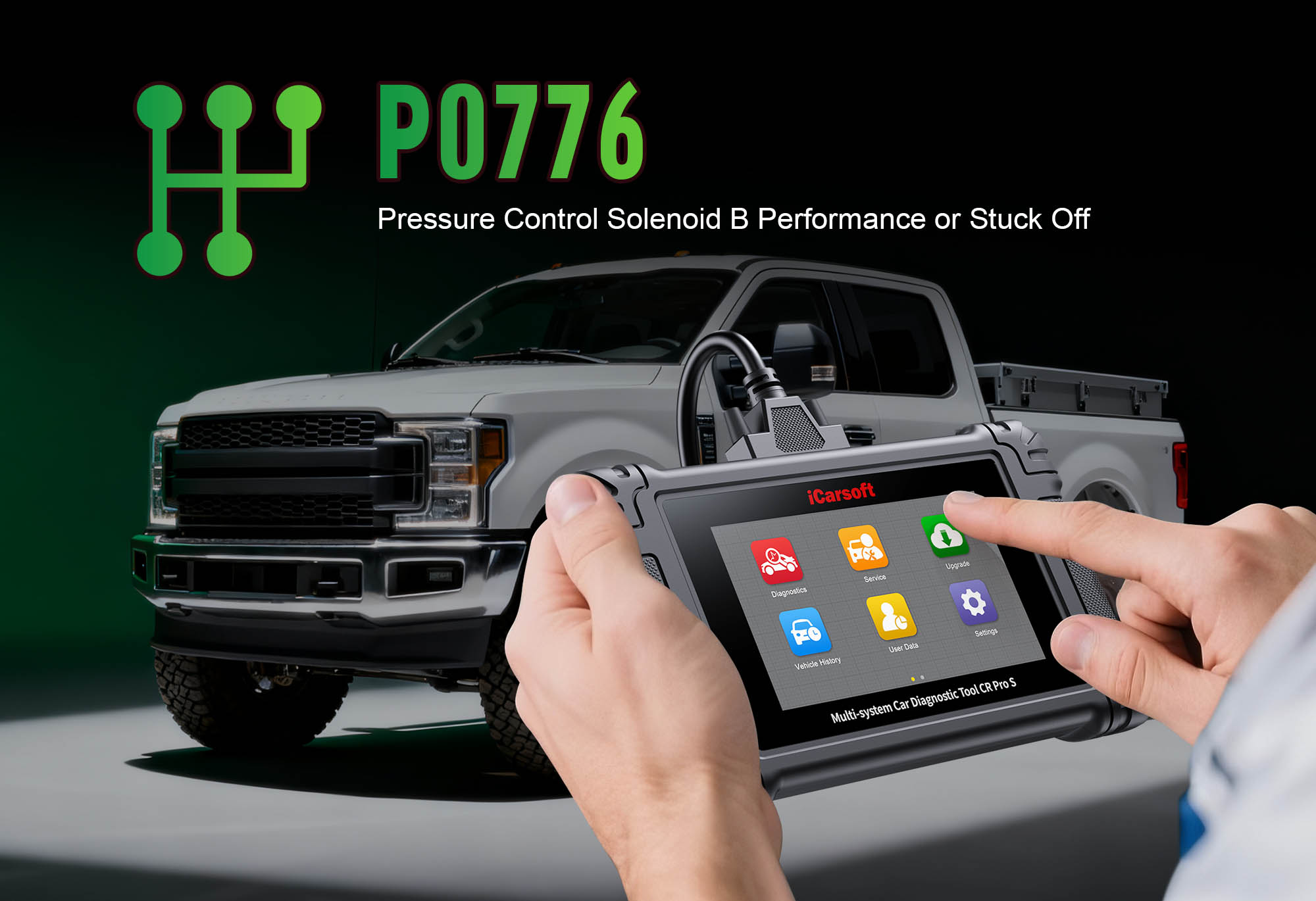P000B Code: Diagnose & Clear Intake Camshaft Position Actuator Performance/Stuck Retarded with iCarsoft CR Pro S
If your check engine light illuminates and you notice symptoms like rough idling, reduced acceleration, or a ticking noise from the engine bay, a diagnostic scan will likely return P000B. This OBD-II code stands for "Intake Camshaft Position Actuator Performance/Stuck Retarded," indicating the Engine Control Module (ECM) has detected the intake camshaft’s timing adjuster (actuator) is either malfunctioning or stuck in a "retarded" position—meaning intake valves open/close later than the ECM’s target timing.
Modern engines use Variable Valve Timing (VVT) systems to optimize performance, fuel efficiency, and emissions. The intake camshaft actuator (hydraulic/electric) adjusts timing based on RPM and load: advancing at low RPM for smooth idle, retarding at high RPM for power. If stuck retarded or unresponsive, valve timing falls out of sync—causing poor performance and triggering P000B. Left unaddressed, this can lead to valve damage, piston-to-valve contact, or complete engine failure.
Basic scanners only flag "camshaft actuator fault" but can’t test VVT oil pressure or actuator movement. The iCarsoft CR Pro S, with VVT-specific diagnostics, live timing tracking, and actuator tests, solves this. Let’s walk through precise diagnosis and resolution.
Understanding P000B: Causes & Key Symptoms
A faulty intake camshaft actuator disrupts valve timing, with symptoms worsening as timing drifts—these clues separate oil-related issues from component failures.
Key Symptoms of P000B
-
Rough Idling: Engine shakes at 500–1,000 RPM due to late-opening intake valves causing incomplete combustion.
-
Reduced Acceleration: Sluggish performance at low RPM—mismatched valve/piston timing limits power.
-
Ticking Engine Noise: Rhythmic ticking from the engine top (near camshaft) indicates stuck actuator or low oil pressure.
-
Increased Fuel Consumption: Poor timing reduces efficiency, leading to 10–15% higher fuel usage.
-
Engine Misfires: Sputtering under load (e.g., hill climbing) from unburned fuel/air mixtures.
-
Cold Start Issues: Struggles to start in cold weather—actuator can’t advance timing for easier cold combustion.
Common Causes of P000B
|
Cause
|
Description
|
|
Low/Contaminated Engine Oil
|
VVT relies on clean, pressurized oil—low levels or sludge block passages, stopping actuator movement.
|
|
Faulty Intake Camshaft Actuator
|
Internal wear (broken springs, leaking seals) traps the actuator in the retarded position.
|
|
Clogged VVT Oil Control Valve (OCV)
|
Debris/carbon clogs the OCV (regulates oil flow to actuator), cutting off oil delivery.
|
|
Wiring/Connector Issues
|
Corroded terminals or frayed wires interrupt ECM signals to the OCV/actuator.
|
|
Stretched Timing Chain/Belt
|
Worn chain/belt shifts base camshaft timing—actuator can’t compensate for the drift.
|
|
ECM Malfunction
|
Outdated firmware or internal faults send incorrect signals to the actuator (rare in 2016+ vehicles).
|
Why iCarsoft CR Pro S Excels at Diagnosing P000B
The CR Pro S outperforms basic tools with VVT-specific features, critical for isolating P000B’s root cause:
Live Camshaft Timing Tracking
Monitors intake camshaft position (relative to crankshaft) to spot retarded timing deviations (>5 degrees off target).
VVT Oil Pressure Tests
Measures oil pressure to actuator/OCV—identifies low-pressure issues (clogged passages, faulty pump).
Actuator Function Tests
Sends bi-directional signals to test advance/retard movement—confirms if the actuator is stuck.
OCV Control Tests
Manually activates the oil control valve to check flow regulation—rules out OCV failure quickly.
Global VVT Coverage
Works with 500+ VVT-equipped models (Toyota, Ford, Chevrolet, BMW, Mercedes-Benz) for brand-specific systems.
ECM VVT Calibration
Resets ECM timing parameters—fixes false P000B triggers from outdated software.
Step-by-Step: Diagnose P000B with iCarsoft CR Pro S
-
Check Engine Oil Level & Quality First
1. Turn off the engine and wait 5 minutes (let oil drain to the pan). Pull the dipstick—oil must be between "MIN" and "MAX." Add manufacturer-recommended oil if low.
2. Inspect oil quality: Clean oil feels smooth; dirty oil is gritty or has a burnt smell. If black/sludgy, change oil + filter before proceeding.
-
Connect the CR Pro S & Confirm the Code
1. Plug into the OBD-II port (use OBDI adaptors for older models: Mercedes 38Pin, BMW 20Pin).
2. Select your vehicle via Auto VIN Identify (instant specs) or manual entry.
3. Navigate to Engine > Fault Codes > Read Codes to confirm P000B. Tap Code Details for tips (e.g., "Toyota Camry 2.5L: Target VVT Oil Pressure = 35–45 psi").
-
Locate VVT System Components
1. Go to Component Location > Engine > Variable Valve Timing > Intake Camshaft Actuator.
2. Use the diagram to identify:
- Intake Camshaft Actuator: Mounted on the front of the intake camshaft (top of engine) with a wiring connector and oil inlet.
- VVT OCV: Attached to the cylinder head near the actuator (has oil lines and a wiring connector).
- Timing Chain/Belt: Visible under the timing cover—check for slack/wear.
- Oil Passages: Small channels in the cylinder head (deliver oil to VVT components).
-
Analyze Live Camshaft Timing Data
1. Start the engine and reach operating temperature (5–10 minutes).
2. Navigate to Engine > Live Data > VVT System and monitor:
- Intake Cam Position: Normal = ±3 degrees of target. P000B = >5 degrees retarded (e.g., target 0° → actual -6°).
- VVT Oil Pressure: Normal = 30–50 psi. <25 psi = low pressure (clogged passages/pump fault).
- OCV Duty Cycle: Normal = 20–80%. Stuck at 0%/100% = OCV not regulating flow.
- RPM vs. Timing: At 2,000 RPM, timing should advance 5–10 degrees from idle. No advance = stuck actuator.
-
Test the VVT Oil Control Valve (OCV)
1. OCV Activation Test: - Go to Special Functions > Engine > VVT System > OCV Control Test. The tool sends varying duty cycles to the OCV.
- Monitor oil pressure: Should rise/fall with duty cycle. No change = OCV clogged/faulty (replace).
2. Physical Inspection: - Remove the OCV (use Torque Guide). Clean passages with brake cleaner. Test resistance (specs: 10–20 ohms). Erratic resistance = faulty OCV.
-
Test the Intake Camshaft Actuator
1. Actuator Movement Test: - Select Special Functions > Engine > VVT System > Actuator Function Test. The tool signals advance/retard.
- Monitor cam position: Should move ±5 degrees from target. No movement = stuck actuator (replace).
2. Oil Inlet Check: - Disconnect the actuator’s oil line. Crank the engine 2 seconds—oil should spray (confirms flow). No spray = clogged passage (clean with a small wire).
3. Visual Check: - Remove the actuator (if stuck). Look for broken springs, leaking seals, or sludge—any damage = replacement.
-
Inspect Timing Chain/Belt & Oil Passages
1. Timing Chain/Belt: - Remove the timing cover (follow Disassembly Guide). Check chain slack (<1/2 inch play) or belt wear. Stretched chain = replace (plus tensioner).
2. Oil Passages: - Use low-pressure compressed air to blow out VVT passages. Flush with engine oil to remove remaining debris.
-
Rule Out ECM Issues
1. ECM Firmware Update: - Go to System > Update Manager to install free updates (fixes misinterpreted VVT signals).
2. VVT Timing Calibration: - Select Special Functions > Engine > VVT System > Timing Calibration to reset ECM timing targets.
-
Repair & Clear P000B
1. Fix the root cause:
- Oil Issues: Change oil/filter or top up levels.
- OCV Fault: Clean or replace the oil control valve.
- Actuator Fault: Replace with OEM part (use Part Lookup).
- Timing Chain/Belt: Replace chain/belt + tensioner.
- ECM Issues: Update firmware or calibrate VVT.
2. Clear the code: Navigate to Engine > Fault Codes > Clear Codes to delete P000B.
-
Validate the Repair
1. Recheck live data: Cam position ±3 degrees of target; VVT oil pressure normal.
2. Test drive 40–50 minutes (low idle + high RPM acceleration): No rough idling, ticking, or warnings.
3. Post-drive scan: Use VVT System Scan after 100 miles to confirm P000B doesn’t return.
Preventing P000B Recurrence
Use the iCarsoft CR Pro S to maintain VVT system health long-term:
-
Oil Maintenance: Set Service Reminder for oil changes every 5,000–7,500 miles (use full-synthetic oil for VVT systems).
-
VVT Checks: Include OCV/actuator tests in annual engine scans—catch clogged valves or low pressure early.
-
Timing Component Inspection: Check chain/belt tension every 60,000 miles (replace chains at 100k, belts at 60k).
-
VVT System Cleaning: Use a VVT cleaner (e.g., Liqui Moly) every 30,000 miles to prevent sludge buildup.
Conclusion
P000B’s intake camshaft actuator fault threatens engine performance and reliability—but the iCarsoft CR Pro S simplifies diagnosis with live timing tracking, OCV tests, and actuator checks. Whether fixing low oil pressure, replacing a stuck actuator, or updating the ECM, this tool ensures you address the root cause (not just the symptom).
With the CR Pro S, you’ll restore proper valve timing, eliminate rough idling, and keep your engine running at peak efficiency—no more costly valve damage or unexpected breakdowns.
FAQs About P000B Code
Q: Can I drive with P000B?
A: Only short distances (to a repair shop). Prolonged driving increases risk of valve/piston damage. Fix P000B within 1 week.
Q: How much does it cost to fix P000B?
A: $50–$150 for oil change/OCV cleaning; $200–$400 for OCV replacement; $300–$800 for actuator replacement; $800–$1,500 for timing chain/belt service. The CR Pro S saves by avoiding unnecessary component swaps.
Q: Will an oil change fix P000B?
A: Yes—if P000B is caused by low/dirty oil clogging VVT passages. If the actuator/OCV is faulty, an oil change alone won’t resolve it (use the CR Pro S to diagnose first).
Q: What’s the difference between P000B and P000A?
A: P000B = "Intake Camshaft Actuator Stuck Retarded," while P000A = "Intake Camshaft Actuator Stuck Advanced." The CR Pro S distinguishes them via live timing data (retarded = negative offset, advanced = positive offset).




